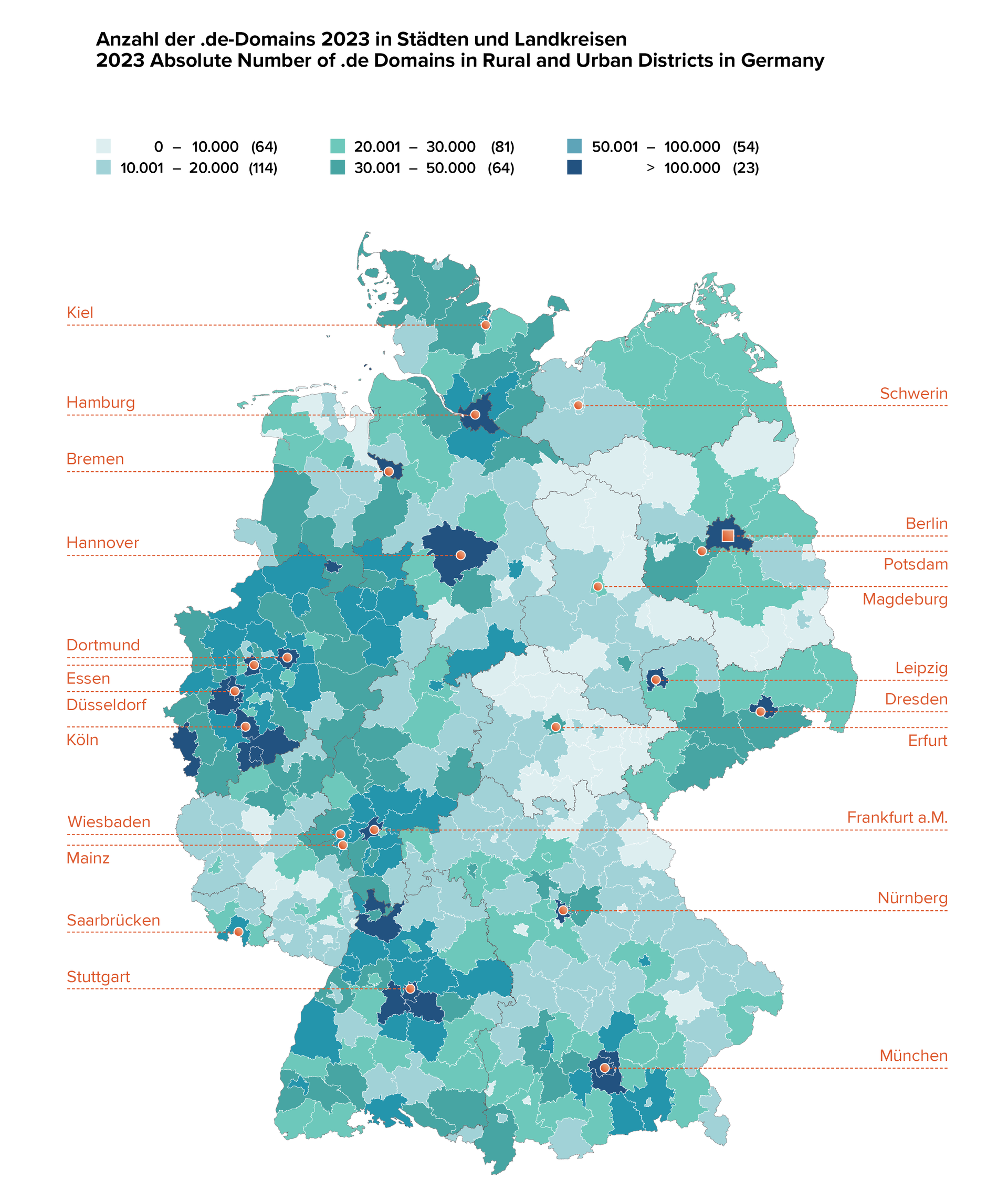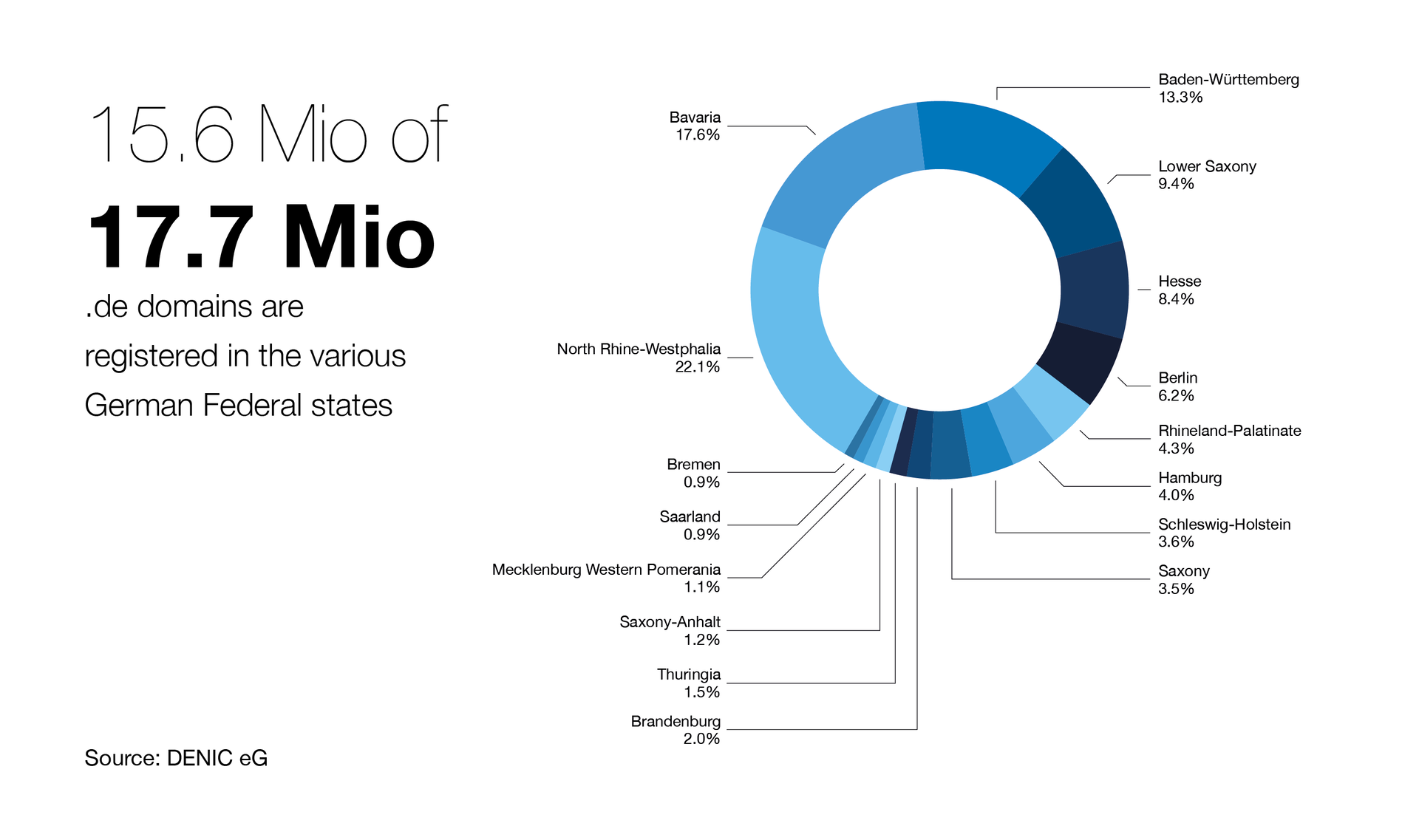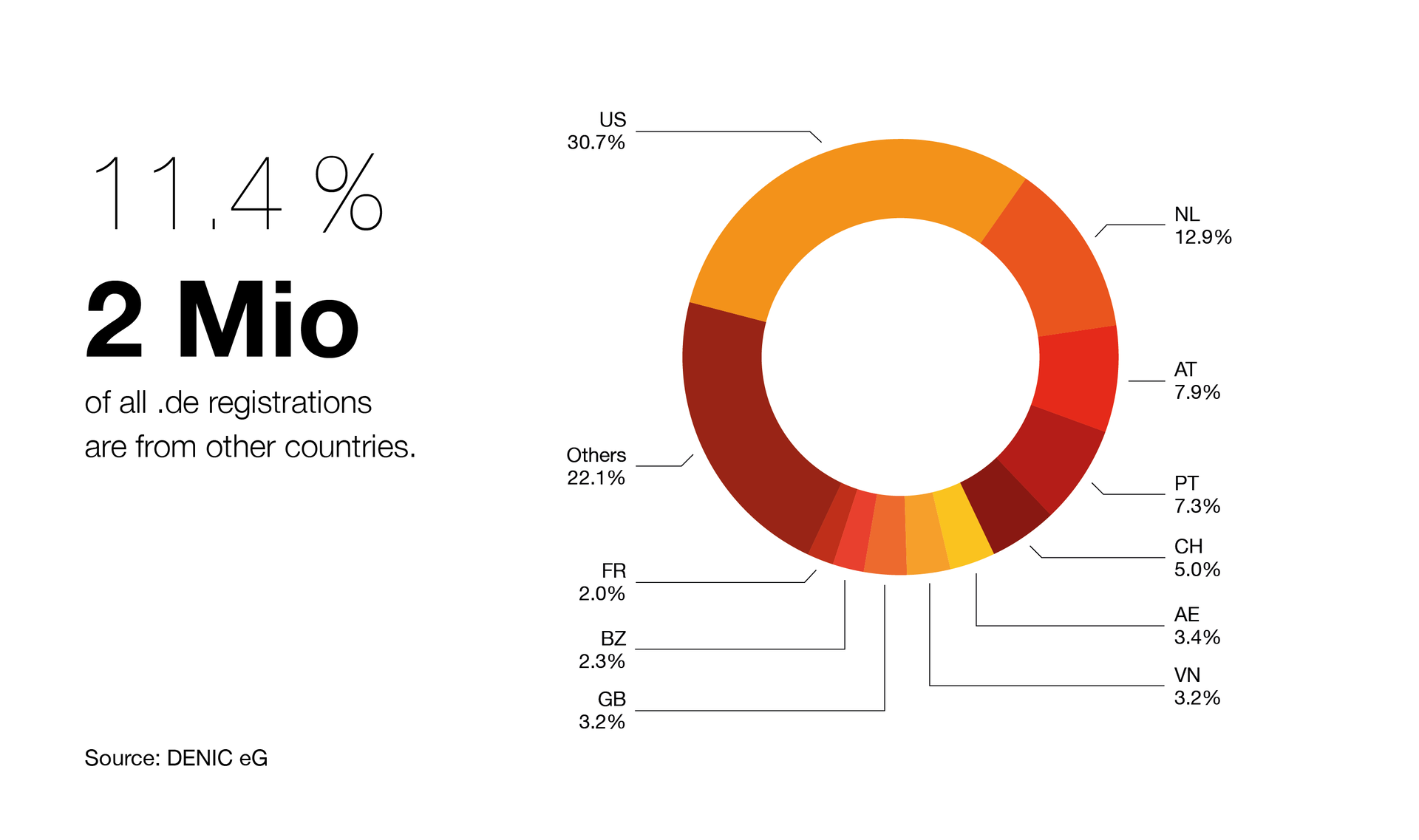DENIC Domain Map 2023
The German country code .de clearly remained on course for growth in 2023. At the end of the year, the number of .de domains registered worldwide had grown to about 17.7 million. Every year, the precise geographic distribution of .de domains is mapped in the annual regional domain statistics published by DENIC. The registry managing all domains with the national ending .de now presents the results of 2023.
As of 31 December 2023, 15.6 million .de domains were registered in the 400 cities and districts of Germany. Adding to these numbers are more than 2 million domains of holders residing abroad. In total, DENIC managed 17,654,263 domains on 31 December 2023. All in all, the .de domains under management increased by 230,000, while the number of.de domains registered in the cities and districts of Germany grew by about 65,000. Statistically speaking, one in five inhabitants of the Federal Republic of Germany has a .de domain.
Municipal Level: Districts Account for Domestic Growth – Cities in General Are Stagnating
Looking at absolute domain numbers, the top places were held by the large cities again. Scoring 970,279 .de domains, Berlin stayed clearly in the lead despite a slight decline in domain numbers, well ahead of Hamburg (617,931) and Munich (544,565). The ranking at the top also remained more or less the same, when referring the number of .de domains to the number of inhabitants: Osnabruck came first with 1,699 .de domains per 1,000 inhabitants, far ahead of the other two top runners in the city league, Bonn (369) and Munich (366). As to the districts, those with the highest domain density related to inhabitants were located in the south of Germany again, namely Bavaria: Miesbach (642 domains) once more scored first before Starnberg (507) and Freising (409).

The national average was 187 .de domains per 1,000 inhabitants (higher individual statistical values reflect local domain investors with larger-scale domain portfolios). Roughly one quarter of the cities and districts included in the analysis exceeded the reference value, whereby the number of cities (50) with above-average values was higher than the respective number of districts (46). Measured in absolute numbers, the 294 districts, which account for 8.9 million of all registered .de domains, reported domain growth. The 106 cities, in contrast, recorded a slight decline to 6.7 million .de domains as of the end of 2023.
Regional Level: Percentage Growth in the East of Germany Exceeds Increase in the West
The ranking on the federal-state level for the number of domains related to inhabitants also was consistent in 2023. The state of Hamburg – comprising the city of Hamburg and its wider outskirts – with 313 domains per 1,000 inhabitants maintained its uncontested leading position well ahead of Berlin (264). Next in line are Bavaria and Hesse with their vast lands, scoring 208 each. Mecklenburg-Western Pomerania (111), Thuringia (109) and Saxony-Anhalt (87) brought up the rear again, even though domain numbers increased in these states, too. The overall national growth rate related to the number of domains was plus 0.4 percent on the previous year (0.8%). Looking at the complete German territory, ten federal states scored values above the mean value, with Schleswig-Holstein (2.1%), Brandenburg (1.6%), Saxony-Anhalt (1.1%) and Lower Saxony (1.1%) in the lead. All federal states saw an increase in .de domain numbers in 2023, except for Berlin (-2.9%) and Saarland (-0.4%). However, the percentage growth of Thuringia (0.36%), Rhineland-Palatinate (0.32%), Bremen (0.25%) and Bavaria (0.03%) was below the federal average.

Excluding Berlin, the 2023 average percentage domain growth among the states in the east of Germany (+0.89%) was slightly higher than that of those in the west (+0.62%). The west-east divide in the distribution of .de domains across Germany, though, remained almost unchanged. As in the last years, the largest number of domains was recorded for North Rhine-Westphalia (3,434,204) which experienced also the highest absolute annual growth (+31,413). The so-called Free State of Saxony with 550,949 registered .de domains (+4,187) once again achieved the highest density among the federal states in the east of the country and maintained place ten in the overall German ranking. Brandenburg recorded the highest domain growth in this region (+4,951). The smallest number of .de domains continued to be reported for the city state of Bremen (134,271).
International Level: Number of .de Domains Beyond German Borders Crack 2-Million Mark
Compared on an annual level, the total number of .de domains under management rose by 1.3 percent in 2022/2023 compared to a plus of 1.5 percent in 2021/2022. This was an increase of more than 230,000 .de domains (20220: +260,000 domains). The roughly 17.7 million .de domains registered worldwide at the end of 2023 included more than 2 million domains of holders residing outside of Germany (2022: 1.8 million). Their share grew by 9.2 percent (2022: +8.9%) and accounted for 11.4 percent of all .de domains at the end of the year (2022: 10.6%).

The holders of .de domains residing outside of Germany originated from all over the world. As in the past, German domains were in particularly high demand in the United States (31%) and the Netherlands (13%). Austria (8 %), Portugal (7 %) and Switzerland (5 %) came next again. Also included in the group of the top ten were the United Arab Emirates and the United Kingdom (3% each) as well as France (2%); together they accounted for more than three quarters of the .de domain inventory of holders from abroad. . de. is especially popular in the EU countries; half of the domain holders listed in the top 10 are based. there.
Detailed Online Data Available
Interactive domain maps and dynamic tables for all 400 cities and districts as well as extensive data and graphic material are available in the statistics section of the DENIC website. Here, you also find all the annual analyses since 1999. In addition to absolute values, the statistics provide data on the number of domains related to the number of inhabitants, complemented by maps and diagrams showing the absolute and the relative distribution of domestic domains as well as of domain holders residing outside of Germany.